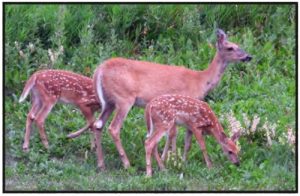
‘May’ I draw your attention to a wild neighbour I hold ‘deer’? May is a fascinating time for me to watch the White-tail Deer because there is so much going on in their lives. The lack of snow means that the “deer yards” where they have been gathering as one or two dozen member groups can start to disperse into smaller family groups again. Every yearling (last year’s babies) that I see I congratulate for making it through the harsh first winter that often takes the weak. Cold temperatures, snowpack covering food sources and predators all make winter an incredibly difficult time to survive. If there are twins, or very rarely triplets, that are still following their larger mom, I congratulate the mom too for being savvy and wise in the ways of the prairie/foothills cold. At the same time, I feel sad because in a week or two she will leave the yearlings on their own, sometimes even aggressively chasing them off so that she can have the privacy needed for having this year’s fawns (a baby deer). If the yearlings have learned well, then the bursting buds and green shoots of grass will get them through another year on their herbivore diets.
It is also an excellent time of year to watch as the white-tails shed their thick winter coats of greyish brown to the reddish browns of summer. You can often find clumps of their hair scattered about the forests and fields. It is easily distinguished from fur bearing mammals as when you rub it in your fingers it feels more coarse like our own hair as opposed to the fluffiness that you might recognize from petting a cat or dog. This is incredibly beneficial to the nesting birds like the pygmy owls, woodpeckers, and a variety of songbirds. They will gather it in their beaks to use it to line their nests; this will help insulate the eggs and keep the hatchlings cozy and warm. If you do find deer hair, make sure you leave it behind for another wild neighbour to use in their home.
Now the end of May and start of June is when the does (a female deer) will give birth to usually one or two fawns. The doe will immediately lick the fawn clean to avoid smells that might attract an unwanted predator. The fawns themselves do not have well developed scent glands yet, which means they are basically odourless. Since most of their predators hunt with their sense of smell, this makes the fawns almost undetectable. Fawns are also covered in white spots to help them camouflage in the vegetation and will not move or make a sound when they sense danger nearby. The lack of smell is so critical to the fawns that their mother will leave them for hours at a time in between feedings to ensure that predators don’t pick up on her smell. This unfortunately has led to several kidnappings in recent years by humans who think they have come across an abandoned fawn. If you ‘spot’ a fawn lying still in the grass do not approach it or ‘fawn’ over it. Just watch it from a safe distance and you may be rewarded with the sight of a doe returning and a fawn suckling her milk. If you are truly concerned, call the AIWC at 403-946-2361 first before touching the fawn.
Keep your eyes peeled this May for pregnant does, bucks (male deer) with antlers freshly sprouting, yearlings heading out into the world on their own, and those adorable but not abandoned spotted fawns.
Laura Griffin

























